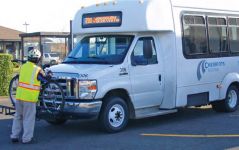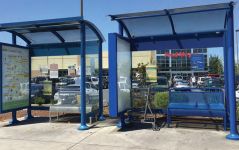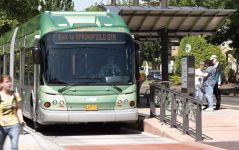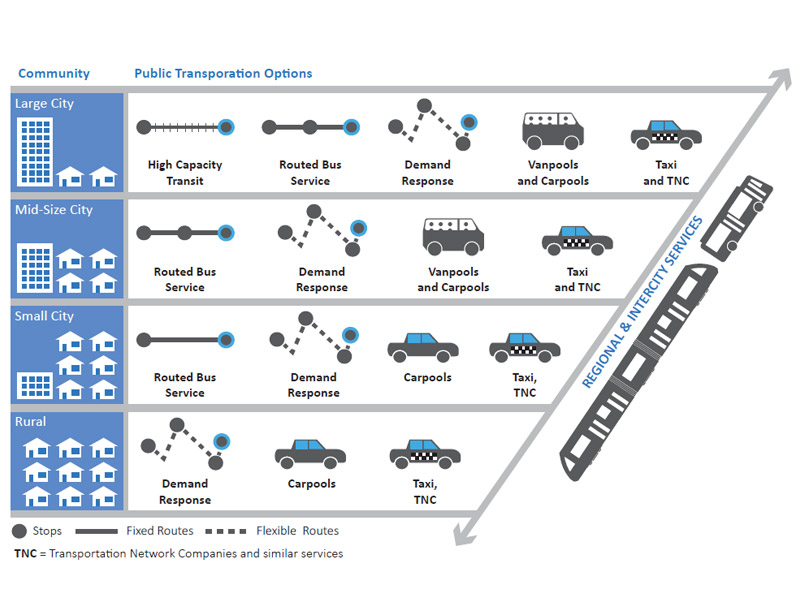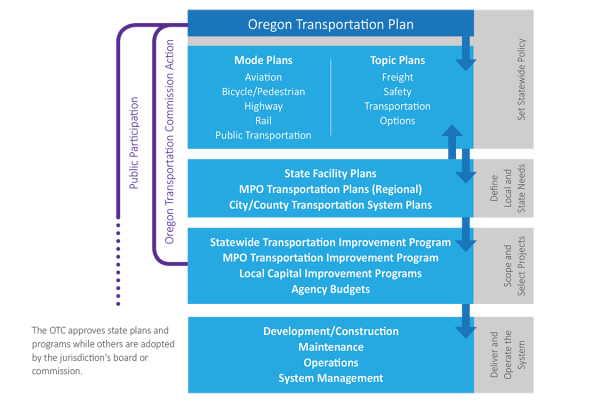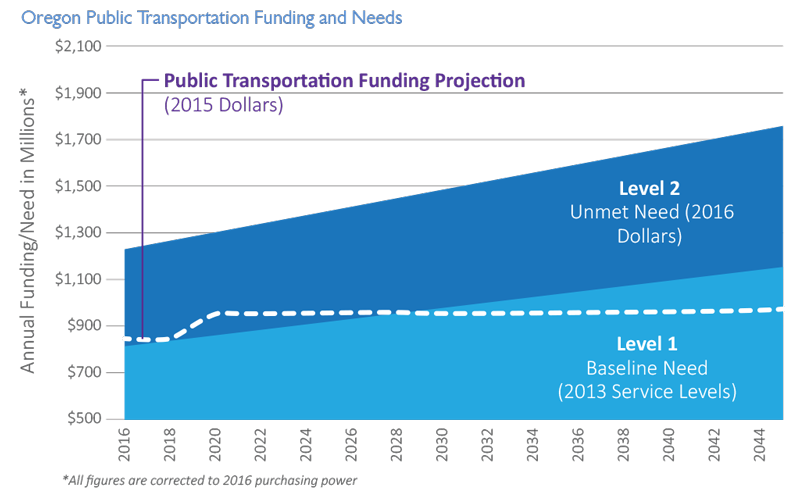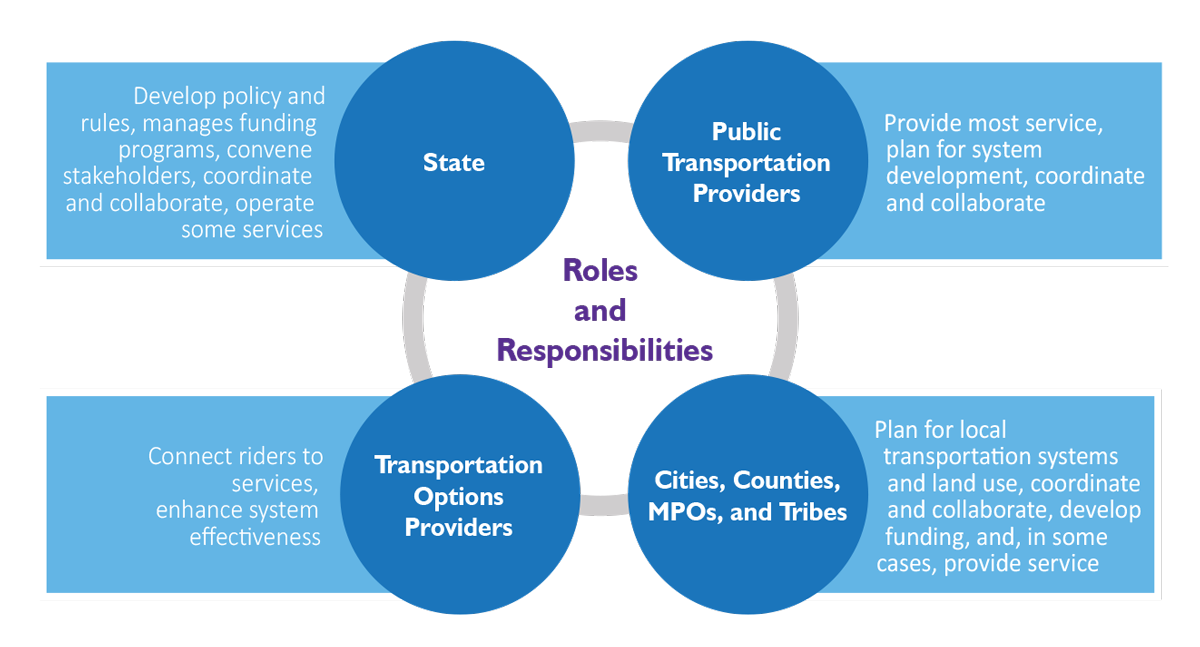Additional Information
OPTP Vision Statement
In 2045, public transportation is an integral, interconnected component of Oregon’s transportation system that makes Oregon’s diverse cities, towns, and communities work. Because public transportation is convenient, affordable, and efficient, it helps further the state’s quality of life and economic vitality and contributes to the health and safety of all residents, while reducing greenhouse gas emissions.
You can skip to a specific section of the plan by clicking the links below, or use the arrows at the top of the page to move through the information in order.
Stations
= Page has questions.
What is the Oregon Public Transportation Plan?
The OPTP sets out goals, policies, and strategies for public transportation, including publicly-operated bus, demand response, rail, and intercity services. The OPTP also considers services such as taxis, network companies like Uber and Lyft, car sharing, carpooling, and vanpooling.
The Oregon Transportation Commission (OTC) is required by law to develop and maintain a state transportation policy and comprehensive long-range plan for Oregon’s multimodal transportation system. The Oregon Transportation Plan (OTP) is the required state transportation system plan, and includes a variety of mode plans, including plans for aviation, bicycle and pedestrian, rail, and public transportation.
How will the Plan be used?
The plan supports decision making by the state, tribes, regional and local agencies, as well as public transportation providers. The OPTP does not direct investments, but serves as a framework to support investment decisions as agencies and providers:
- Identify public transportation investment priorities;
- Identify opportunities to support public transportation; and
- Develop multimodal transportation strategies.
How was the draft Plan developed?
Developing the OPTP relied on input from stakeholders and the public throughout Oregon. A Policy Advisory Committee (PAC) of diverse stakeholders guided content development for the plan, and a Technical Advisory Committee helped work through specific topics to inform PAC discussions. Online and in-person public outreach activities helped gather ideas and feedback from additional stakeholders and the public.
Oregon Public Transportation Plan Vision Statement
The OPTP vision provides guidance for developing public transportation services in Oregon and is supported through the plan goals, policies, strategies, and implementation framework. Developed and reviewed by stakeholders and the public, the vision articulates how Oregonians want public transportation to serve them and the overall transportation system in the future:
In 2045, public transportation is an integral, interconnected component of Oregon’s transportation system that makes Oregon’s diverse cities, towns, and communities work. Because public transportation is convenient, affordable, and efficient, it helps further the state’s quality of life and economic vitality and contributes to the health and safety of all residents, while reducing greenhouse gas emissions.
Read more in Chapter 1: "A New Oregon Vision for Public Transportation"
Public Transportation Options
This illustration shows examples of the different kinds of services that may be found in various communities around our state. As communities grow, more public transportation services are typically available, depending on total population, population density, and other factors.
Public Transportation Benefits Oregon Communities
Connects people and places in urban and rural areas alike
Public transportation connects people to jobs, healthcare, shopping, recreation, and services. For people who cannot drive, public transportation provides critical mobility and access. For others, public transportation provides options: it may be more reliable, more efficient, safer, or more affordable than driving alone.
Supports economic vitality
Public transportation makes Oregon’s economy more vital, keeping money in the pockets of transit riders, attracting businesses and workers, and improving the mobility and reliability for all roadway users.
Improves health and safety
Public transportation improves the health and safety of Oregon communities by making roads safer, reducing air pollution, protecting water quality, and linking people to health care, groceries, and other essential needs.
| Provider Type |
Population Served |
Example Providers |
Additional Details |
|---|---|---|---|
| Large Urban Providers | More than 200,000 | TriMet, Lane Transit District, Cherriots (Salem-Keizer area) | This provider type represent 95% of the public transportation trips in the state; served 115,000,000 trips in 2013. These providers offer the greatest variety of services in the state. |
| Medium Urban Providers | 50,000 to 200,000 | City of Albany, City of Corvallis | This provider type served 2,900,000 trips in 2013. These providers typically offer some fixed route and demand response services. |
| Small Urban Providers | 10,000 to 50,000 | City of Canby, City of Sandy | This provider type served 1,200,000 trips in 2013. These providers typically offer limited fixed route and demand response services. |
| Large County and Regional Providers | Counties greater than 50,000 | Yamhill County, Central Oregon Intergovernmental Council | This provider type served 1,700,000 trips in 2013. Some providers offer fixed route and intercity services; others have more limited demand response systems. |
| Small County and Rural Providers | Counties less than 50,000 and cities less than 10,000 | Harney County, City of Silverton | This provider type served 1,000,000 trips in 2013. These providers typically offer demand response and/or limited fixed route services. |
Public Transportation Today
Oregon has a wide range of public transportation providers, from small nonprofit senior centers offering transit service for older adults, to larger public transportation districts serving both urban and rural residents, to private companies that operate intercity services. The diversity of providers presents both opportunities and challenges for public transportation.
Trends
Understanding trends is important, because they help shape public transportation today and will continue to influence public transportation development in the future.
- Oregon is growing rapidly. The state’s population has increased by about a million new residents since the first OPTP was adopted about 20 years ago.
- Younger and older riders rely on public transportation. More older adults are taking public transportation, and many depend on it for transportation. In addition, younger riders are driving less and relying on a broader range of transportation options.
- Minority and low-income populations are more likely to use public transportation. As these communities continue to grow, demand for public transportation service is likely to grow too.
- Funding public transportation is difficult. Costs to purchase, operate, and maintain vehicles continues to rise. This makes it difficult to sustain existing services, let alone expand. New funding from the Keep Oregon Moving Act will benefit providers across the state, but still won’t meet all public transportation needs.
Opportunities and Challenges
During development of this plan, people from around the state shared insights at conference sessions, public meetings, focus groups, and online open houses about some of these challenges and opportunities to using and providing public transportation.
- Residents, public transportation providers, and other agencies all identified a need for enhanced collaboration and coordination throughout transportation planning and service delivery.
- Connections for pedestrians and bicycle riders to public transportation are essential for public transportation to function. This includes improved sidewalks and safe crossings, as well as exploring bikeshare, carshare and mobility hubs with shared facilities that accommodate connections between modes.
- Closing gaps with regional and intercity connections would benefit visitors and Oregonians who travel to other places for their jobs, services, or other needs.
- Public transportation will be affected by providers continuing to develop and adopt new technologies such as alternative fuels, safety features, automation, communication with other vehicles and infrastructure, trip planning tools and travel information, and electronic fares.
Goals
The policies and strategies are organized by each of the OPTP’s ten goals; they are placed in the most relevant goal area identified, but frequently relate to other goals. The numbers for goals, policies, and strategies are for organization only and do not indicate priority. The goals, policies, and strategies work together to support an efficient, coordinated public transportation system in Oregon that is reliable, safe, welcoming, and accessible.
Goal 1: Mobility - Public Transportation User Experience
People of all ages, abilities, and income levels move reliably and conveniently between destinations using an affordable, well-coordinated public transportation system. People in Oregon routinely use public transportation to meet their daily needs.
Read about Goal 1 and related policies and strategies.Goal 2: Accessibility and Connectivity - Getting from Here to There
Riders experience user-friendly and convenient public transportation connections to and between services and travel modes in urban, suburban, rural, regional, and interstate areas.
Read about Goal 2 and related policies and strategies.Goal 3: Community Livability and Economic Vitality
Public transportation promotes community livability and economic vitality by efficiently and effectively moving people of all ages to and from homes, jobs, businesses, schools and colleges, and other destinations in urban, suburban, and rural areas.
Read about Goal 3 and related policies and strategies.Goal 4: Equity
Public transportation provides affordable, safe, efficient, and equitable transportation to jobs, services, and key destinations, improving quality of life for all Oregonians.
Read about Goal 4 and related policies and strategies.Goal 5: Health
Public transportation fosters improved health of Oregonians by promoting clean air, enhancing connections between people, enabling access to services such as health care and goods such as groceries, and by giving people opportunities to integrate physical activity into everyday life through walking and bicycling to and from public transportation.
Read about Goal 5 and related policies and strategies.Goal 6: Safety and Security
Public transportation trips are safe; riders feel safe and secure during their travel. Public transportation contributes to the resilience of Oregon communities.
Read about Goal 6 and related policies and strategies.Goal 7: Environmental Sustainability
Public transportation contributes to a healthy environment and climate by moving more people with efficient, low-emission vehicles, reducing greenhouse gases and other pollutants.
Read about Goal 7 and related policies and strategies.Goal 8: Land Use
Public transportation is a tool that supports Oregon’s state and local land use goals and policies. Agencies collaborate to ensure public transportation helps shape great Oregon communities providing efficient and effective travel options in urban, suburban, and rural areas.
Read about Goal 8 and related policies and strategies.Goal 9: Funding and Strategic Investment
Strategic investment in public transportation supports the overall transportation system, the economy, and Oregonians’ quality of life. Sustainable and reliable funding enables public transportation services and infrastructure to meet public needs.
Read about Goal 9 and related policies and strategies.Goal 10: Communication, Collaboration, and Coordination
Public and private transportation providers and all levels of government within the state and across state boundaries work collaboratively and foster partnerships that make public transportation seamless regardless of jurisdiction.
Read about Goal 10 and related policies and strategies.Investment Scenarios
The OPTP investment scenarios describe a continuum of services and improvements that make progress towards the OPTP’s vision, goals, policies, and strategies. The scenarios describe how the system could evolve and the results of different levels of public transportation investment. The range of investment scenarios built from these analyses are intended to articulate different futures for the public transportation system, based on more or less funding. All scenarios assume that current local, state, and federal funding sources continue into the future.
Scenario 1: Preservation and Critical Improvements
Description: Current funding, inclusive of the Keep Oregon Moving Act, in addition to modest increases to account for population growth.
Estimated change in funding from today: Modest increase to keep pace with population growth.
- Urban: Modest service increases; extended service hours, more frequent service.
- Rural: Expanded demand response systems and improvement to fixed route service.
- Intercity: Better connections between systems and regions; minor increases in regional and intercity services.
- Technology: Some investment in new vehicles and/or public transportation technologies; expansion of efare.
- Fleet: Equipment generally maintained in good repair.
- Communication and Coordination: More resources devoted to coordination, planning, and communication; more one-stop information available.
Scenario 2: Expanding Services
Description: Significant investment elevates public transportation across the state (equivalent to double the investment from the Keep Oregon Moving Act)
Estimated change in funding from today: +$200 to +$300 million per year, increasing with population growth over time (1.3 to 1.4 times current investment)
- Urban: Substantial service expansion.
- Rural: Demand response service available in most rural locales; limited fixed route service between and within communities.
- Intercity: Increased regional and intercity service.
- Technology: Further steps toward fare integration; further expansion of efare to most public transportation systems in Oregon; expansion of new and emerging technologies.
- Fleet: Major vehicle fleet improvements.
- Communication and Coordination: Substantial benefits to providers and riders resulting from coordination, planning, and communication.
Scenario 3: Realizing the Vision
Description: Additional investment funds most public transportation needs.
Estimated change in funding from today: +$950 to +$1.2 billion per year by 2045 (2.3 to 2.6 times current investment)
- Urban: Major capital investments, including separated transitways and new high capacity transit; almost seamless service with excellent regional connections.
- Rural: Most travel needs met by rural public transportation services.
- Intercity: Riders experience almost seamless service.
- Agency and Rider Experience: Statewide one-stop information available.
- Technology: Full fare integration.
- Fleet: Fleet fully modernized to include low- and zero-emission vehicles.
- Communication and Coordination: Local providers closely coordinated to achieve an almost seamless riding experience.
Roles in Implementation
The OPTP is a statewide plan that applies to all transportation agencies and service providers. The plan informs other public agencies and transportation decision makers, such as tribes, cities, and counties, as well as other organizations important to public transportation, such as social services organizations, private transportation providers, and health care organizations. Successfully implementing the OPTP will take all of these participants.
Key Initiatives
Key initiatives respond to important themes emphasized by stakeholders throughout OPTP development. The initiatives are critical to OPTP success and require further work and development to implement. While ODOT may be able to initiate some short-term work related to these initiatives, most will require long-term effort and collaboration between multiple partners.
Read about the key initiatives.
Public Transportation Plan Integration
This key initiative promotes an effective, efficient, and seamless public transportation system, building on the need to plan for transportation together. The focus of this key initiative is to help agencies further integrate their planning activities; different areas of the state have different histories of plan development and integration. Of course, local agencies can and should undertake these activities as they consider their own efforts to implement this plan, or to update their own local plans. ODOT will look for ways to promote and assist these efforts.
+ View potential activities.- Coordinate activities and actions to help providers:
- Improve planning activities to be more effective and inclusive.
- Participate in one another’s plans and consult with each another.
- Work with regional and local governments to designate public transportation priority corridors.
- Maximize coordination and collaboration between providers, the state, tribes, and local agencies.
- Provide mechanisms for efficient coordination and collaboration.
- Advance equity analysis, and enhance stakeholder involvement in planning.
- Incorporate transit asset management practices as a planning tool.
- Incorporate recent state funding program requirements with planning processes.
- Coordinate services with transportation options providers.
- Use information in Coordinated Plans in transit and transportation system planning, and include human service stakeholders in transit system planning.
- Determine whether developing a broad definition of a basic level of public transportation service that is scalable to different jurisdictions throughout Oregon is feasible. This evaluation may include the following tasks:
- Research possible minimum level of service expectations.
- Study definitions and characteristics of minimum service in different locales.
Read about more about this key initiative.
Regional and Intercity Service
This key initiative focuses on providing public transportation service between cities and regions and connecting Oregon communities to other states. Regional and intercity public transportation emerged as an important topic discussed by stakeholders throughout OPTP development. Moreover, this is a topic where ODOT has a clear role. ODOT’s statewide perspective can assist providers, and ODOT itself can help fill gaps and provide a logical system that links areas throughout the state.
+ View potential activities.- Develop statewide strategies for intercity services:
- Describe the desired intercity network, and identify potential hubs, missing and needed connections, insufficient service routes, and other needs.
- Work with regional and local governments to designate regional and statewide public transportation priority corridors.
- Integrate connections to other modes and first and last mile solutions to demonstrate what a fully functioning multimodal network might include.
- Research and identify:
- Best practices and lessons learned from other places to inform regional and intercity programs and policy.
- Possible barriers to effective regional and intercity service, including governance issues, and actions to address them.
- Fare policy recommendations, possible incentives for service provision, and best practices to balance funding and revenue with fare affordability.
- Support and initiate pilot projects:
- Support and expand one stop traveler information and trip planning opportunities.
- Partner with providers and others to support and expand universal fare opportunities.
- Test potential new services to fill regional and intercity service gaps.
Read about more about this key initiative.
Public Transportation Technology
Transportation technology is rapidly changing and how these changes and new developments will affect public transportation services is not yet known. Changing technology presents new opportunities and challenges for providers and riders alike, such as tools that enable more efficient operations and provide real-time travel information to riders. The OPTP provides a flexible framework to enable ODOT and providers to adapt to changes as they occur. Some technologies are known but not yet fully developed or used in Oregon. This key initiative focuses on efforts to better understand and effectively use technology to help Oregonians meet routine needs via public transportation and promote a seamless and easy to use system.
+ View potential activities.- Evaluate, acquire, develop, and share technologies and standards statewide, incorporating these into procedures and researching and further describing technology alternatives and methods of accomplishing results such as the following:
- Standards, methods, platforms, and/or guidance for data collection, governance, sharing, and use.
- Public transportation planning aids, including transit planning software, transportation model improvement, and other analysis tools.
- Effective and timely communication of services available and travel options to communities served and riders via online, mobile, and other means.
- Enhanced statewide online and other services, building on existing statewide transportation options and traveler information services.
- Effective communication systems among and between vehicles, infrastructure, and operations centers.
- Shared efare systems and other shared or interoperable technologies.
- Pilot projects to test new technologies, vehicle technologies, and service delivery models, such as testing various small vehicle first and last mile transit access technologies and solutions.
Read about more about this key initiative.
Outreach Milestones
Each stage of collaboration has brought the plan closer to completion, with invaluable input from community members and stakeholders.
- 2016: Public input on draft vision, goals, opportunities and challenges
- 2017: Public input on draft policies and strategies
- 2018: Public input on draft plan – final review before plan adoption
- Online Open House: late May to late July We are here
- Public Hearing: July 19 or 20, 2018
- Anticipated adoption: September 20, 2018
Stay in Touch
Sign up for email updates to follow PAC and plan development activities, including public events.
Contact
Lucia Ramirez
Principal Planner
503-986-4168
Jean Palmateer
Region Transit Coordinator
503-986-3472
Michael Rock
Planning Unit Manager
503-986-3179


